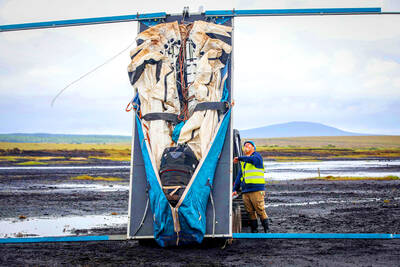Argentina is promoting a new era of mining and energy production, welcoming billions of dollars in foreign investment to unlock huge new reserves of natural gas, oil, gold, lithium and other metals once thought to be unprofitable or out of reach.
However, there’s one factor threatening this resource boom, something politicians and energy executives rarely mention: Huge amounts of fresh water will be required for these operations in a country where water scarcity holds back development and 16 percent of households still lack connections to publicly treated drinking water.
To make good on the promised energy wealth from one large Argentine shale oil and gas deposit announced this year, experts say it could take an estimated 144 billion liters of water — equal to the total daily amount of water supplied by public systems to the entire US.
Other major projects include Pascua Lama, the world’s highest-altitude gold mine, which is poised to open along the spine of the Andes and produce precious metals for 25 years. The rock will be processed on the Argentine side of the Chilean border with a mix of cyanide and 14 billion gallons of water, Canadian mining giant Barrick Gold Corp says.
The company says it uses less than 1 percent of available river water for its gold mines, but downstream in San Juan Province, people already face water-use restrictions and must pay 99 times more for water than what Barrick Gold pays under a deal with provincial officials, said lawmaker Miguel Bonasso, who leads the Argentine congress’s natural resources commission and sponsored a controversial Glacier Law that promises to create a scientific inventory of the nation’s water resources.
“If Barrick Gold had to pay for this water, it wouldn’t invest in the mine — it wouldn’t be profitable,” Bonasso said on Friday.
Argentina’s mining ministry, meanwhile, estimates that US$50 billion worth of lithium can be harvested from the salt flats of Jujuy Province alone, about equal to the nation’s entire foreign reserves. Extracting lithium for use in batteries that power cellphones, laptops and electric cars requires water to create a dirty brine, which indigenous groups fear will destroy their traditional salt-collecting livelihood.
However, most of the attention recently has focused on the discovery of a huge deposit of gas and oil trapped in shale rock deep under the “Vaca Muerta” (Dead Cow) basin in Neuquen Province. While 90 percent of its key deposits are unexplored, Vaca Muerta could increase Argentina’s oil reserves by at least 750 million barrels, and probably three times that much, said Michael Lynch, an oil analyst and president of Strategic Energy and Economic Research.
Vaca Muerta also has an estimated 127 billion cubic meters of natural gas, according to Spain’s Repsol-YPF energy company.
The discovery boosts the country’s “technically recoverable” shale gas reserves to 22 trillion cubic meters, according to US Department of Energy estimates, potentially making Argentina the world’s third-largest provider of shale gas, behind China and the US.
“It’s more than important, because it will enable us to keep sustaining and promoting even more development for all Argentines,” Argentinian President Cristina Fernandez said when she announced the discovery earlier this year.
She followed up in New York last week by securing US$1.15 billion in promised investments from executives with Exxon Mobile Corp, AES Corp and Apache Corp.
Long thought worthless, such deposits are now accessible through what is known as “slick-water hydraulic fracturing and horizontal drilling,” or “fracking,” for short. This technology involves drilling deep down and then horizontally through the shale, setting off explosions and then injecting a mixture of fresh water, sand and chemicals at high pressure to force the fuel to the surface.
Fracking takes between 19 million and 23 million liters of water per well and it would take many thousands of wells to extract what they’re hoping to produce, said Cornell University engineering professor Anthony Ingraffea, an expert on the complex mechanics of fracturing rock deep underground.
In arid western Argentina, the water would have to be drawn from underground aquifers or from reservoirs and rivers fed by Andean snows and glaciers.
Once used for fracking, it is usually too contaminated to be recycled for drinking water or agriculture. In the US, this wastewater is often injected deep underground, where environmentalists say there are no guarantees it won’t contaminate groundwater.
“It’s about to get a lot drier” in these parts of Argentina, said Ingraffea, who advocates limiting fracking because of complaints of water contamination.
Fracking varies based on each site’s geology, but the Barnett Shale deposit in similarly dry north Texas has used more than 15,000 wells to produce more than 25 billion cubic meters of gas over 18 years, Texas said. So if Vaca Muerta needs about half that number of wells for about half the gas, it could take 144 billion liters of water to extract it all, based on what Ingraffea calls a conservative industry standard of 19 million liters per well.
“Clearly, that’s a hell of a lot of water,” said Daniel Talliant, who runs Argentina’s Center for Human Rights and the Environment. “I would also stress the importance and risk posed to subterranean aquifers, which are a critical and delicate resource.”
The oil and gas industry maintains that it can keep nearby groundwater supplies clean, but environmentalists are increasingly challenging this claim, citing poisoned wells and fish die-offs in nearby waterways. So if the US hasn’t resolved this debate through its relatively swift justice system and extensive environmental regulations, is Argentina — or any country in the developing world — prepared to do any better?
Talliant doesn’t think so.
“We’ve been doing these things for years without social conscience,” he said. “It’s only recently that we’ve begun to realize that we’re placing our critical environmental resources at risk.”
Argentina’s Glacier Law, passed in November last year, bans virtually all human activity on glaciers and adjacent areas of rocky permafrost that were recently covered in ice and still hold water. It requires an inventory of water from glacial runoff, data that could build support for downstream protections as well. Most of the water in the western Andean foothills flows down from glacial peaks, just where most mining activity is planned.
Fernandez vetoed an earlier Glacier Law under pressure from pro-mining provincial allies before allowing the latest version to pass, but it was immediately blocked in court by mining companies and provincial officials, and she hasn’t supported it since then, Bonasso said.
Indigenous groups, meanwhile, have alleged that the provinces are allowing their water to become contaminated. In 2001, Mapuches in Neuquen got clean drinking water trucked into their community by going to the Inter-American Commission on Human Rights. Several dozen other indigenous communities also sued, accusing their provincial governments of exploiting minerals and ruining their water without consulting them.
Most of these cases are now before Argentina’s Supreme Court, which must weigh environmental protections against provincial mining rights under the constitution.

A proposed 100 percent tariff on chip imports announced by US President Donald Trump could shift more of Taiwan’s semiconductor production overseas, a Taiwan Institute of Economic Research (TIER) researcher said yesterday. Trump’s tariff policy will accelerate the global semiconductor industry’s pace to establish roots in the US, leading to higher supply chain costs and ultimately raising prices of consumer electronics and creating uncertainty for future market demand, Arisa Liu (劉佩真) at the institute’s Taiwan Industry Economics Database said in a telephone interview. Trump’s move signals his intention to "restore the glory of the US semiconductor industry," Liu noted, saying that

On Ireland’s blustery western seaboard, researchers are gleefully flying giant kites — not for fun, but in the hope of generating renewable electricity and sparking a “revolution” in wind energy. “We use a kite to capture the wind and a generator at the bottom of it that captures the power,” said Padraic Doherty of Kitepower, the Dutch firm behind the venture. At its test site in operation since September 2023 near the small town of Bangor Erris, the team transports the vast 60-square-meter kite from a hangar across the lunar-like bogland to a generator. The kite is then attached by a

Foxconn Technology Co (鴻準精密), a metal casing supplier owned by Hon Hai Precision Industry Co (鴻海精密), yesterday announced plans to invest US$1 billion in the US over the next decade as part of its business transformation strategy. The Apple Inc supplier said in a statement that its board approved the investment on Thursday, as part of a transformation strategy focused on precision mold development, smart manufacturing, robotics and advanced automation. The strategy would have a strong emphasis on artificial intelligence (AI), the company added. The company said it aims to build a flexible, intelligent production ecosystem to boost competitiveness and sustainability. Foxconn

STILL UNCLEAR: Several aspects of the policy still need to be clarified, such as whether the exemptions would expand to related products, PwC Taiwan warned The TAIEX surged yesterday, led by gains in Taiwan Semiconductor Manufacturing Co (TSMC, 台積電), after US President Donald Trump announced a sweeping 100 percent tariff on imported semiconductors — while exempting companies operating or building plants in the US, which includes TSMC. The benchmark index jumped 556.41 points, or 2.37 percent, to close at 24,003.77, breaching the 24,000-point level and hitting its highest close this year, Taiwan Stock Exchange (TWSE) data showed. TSMC rose NT$55, or 4.89 percent, to close at a record NT$1,180, as the company is already investing heavily in a multibillion-dollar plant in Arizona that led investors to assume